Wednesday, May 30 marks the one-third mark through the minor league regular season, a good time to check in with the OFR Top 30 prospects and see how they are doing. This is the first part of a two-part post, looking at prospects #1-15.
CLICK HERE FOR PROSPECTS #16-30
(All stats presented are through Tuesday, May 29)
1. Ronald Acuña, Jr., OF

AAA: .232/.321/.304 | 78 PA | 1 HR | 4 SB | 11.5 BB% | 28.2 K% | 84 wRC+
MLB: .265/.326/.453 | 129 PA | 5 HR | 2 SB | 7.8 BB% | 28.7 K% | 112 wRC+
The top prospect in baseball by most sources going into 2018 was called up to Atlanta on April 25 and started every game until what the team termed a “mild strain of the ACL” put him on the DL in May 28.
His time with the big league club has gone pretty much as most reasonable observers expected. He has shown himself to be an extremely exciting player, hitting rockets all over the field and using his speed to generate memorable moments on the base-paths and in the outfield. At the same time, major league pitchers have started to exploit his aggressiveness at the plate, and poor route running has lead to some unsightly defensive miscues.
Acuña has mostly hit in the #2 spot in the batting order, between Ozzie Albies and Freddie Freeman, and that should be a good spot for him in the long-term. He had repeatedly shown to be able to make rapid adjustments to new pitching strategies, and before his injury he seemed to be doing so again, getting nine hits over the previous week. Acuña is two major league at-bats away from losing prospect status.
See also: Get To Know a Call-Up: Ronald Acuña, 5 Things About Ronald Acuña
2. Mike Soroka, RHP

AAA: 1.99 ERA | 1.93 FIP | 4 G, 4 GS | 22.2 IP | 1.99 BB/9 | 9.53 K/9
MLB: 3.68 ERA | 2.77 FIP | 3 G, 3 GS | 14.2 IP | 2.45 BB/9 | 9.20 K/9
Soroka earned a major league call-up after showing in four AAA starts that the minor leagues no longer held much of a challenge for the 20-year-old. On May 1, Soroka made his major league debut against the Mets and allowed 6 hits and 1 earned run in 6 innings pitched. His subsequent two starts weren’t quite as sharp, though Soroka has done a good job limiting hard contact.
After a start at Miami on May 12, Soroka experienced discomfort in his right shoulder. While examination didn’t uncover any damage to the joint, the Braves elected to play it safe with their top pitching prospect, placing him on the 10-day DL. Soroka is expected to get a rehab start this week and could return to Atlanta soon.
See also: Get To Know a Call-Up: Mike Soroka
3. Luiz Gohara, LHP

AA: 2.70 ERA | 3.73 FIP | 1 G, 1 GS | 3.1 IP | 8.10 BB/9 | 10.80 K/9
AAA: 8.03 ERA | 8.82 FIP | 3 G, 3 GS | 12.1 IP | 5.11 BB/9 | 8.03 K/9
MLB: 2.45 ERA | 3.93 FIP | 4 G, 1 GS | 11.0 IP | 4.91 BB/9 | 9.00 K/9
After a terrific 2017 season that saw Gohara rocket from advanced-A ball to the majors by September, Gohara has had a tough go of it. In December, Gohara’s father passed away suddenly. In spring training, where Gohara expected to earn a spot in the Opening Day rotation, Gohara suffered two separate injuries that delayed the start of his season. Gohara had four rehab starts before being recalled to the majors on May 10. With Mike Soroka having secured the 5th starter role, Gohara pitched out of the bullpen for three outings before getting a start on May 23. Gohara was then placed on the berevement list to allow him to go home to his native Brazil where his mother had recently had serious coronary surgery.
Between the stops, starts, and tragedy however, Gohara has shown resilience. Perhaps as a result of his abbreviated spring, his fastball hasn’t shown quite the same velocity as last season, sitting in the 92-94 mph range instead of the 95-97 and hitting 99 on occasion of 2017. Gohara has leaned heavily on his slider, a smart move given that it’s the best in the Braves organization. While eschewing the change-up while pitching in relief, Gohara broke it out in his start on the 23rd; if Gohara returns to the rotation, command of the change-up will be key to going deep into games.
4. Kyle Wright, RHP
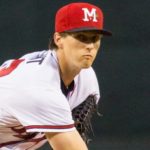 AA: 4.27 ERA | 3.52 FIP | 11 G, 11 GS | 52.2 IP | 4.34 BB/9 | 8.67 K/9
AA: 4.27 ERA | 3.52 FIP | 11 G, 11 GS | 52.2 IP | 4.34 BB/9 | 8.67 K/9
Despite a somewhat unslightly ERA, Wright has pitched well to start his first full professional season. Mississippi’s pitching coach, Dennis Lewallyn, is notorious for forcing his pitchers to work on areas of weakness, and Wright will go several games rarely using his best pitch, a tight 12-6 curveball, in order to work on fastball command or the change-up.
Control of his pitches will continue to be a point of emphasis for Wright at AA in order to allow him to work deeper into games. Mechanically, Wright also needs to work on repeating his delivery, and he will occasionally rush his motion. When he gets off like this, it leads to short outings. Overall it seems unlikely at this point that Wright will be in Atlanta this September as some more optimistic pre-season projections had him, but that’s the fault of the projections. A full season in AA for Wright would be just fine, but an emphases on results and organizational need could find Wright in AAA.
5. Kolby Allard, LHP
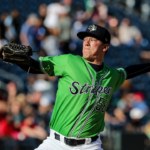 AAA: 2.09 ERA | 3.64 FIP | 9 G, 9 GS | 56.0 IP | 2.41 BB/9 | 6.11 K/9
AAA: 2.09 ERA | 3.64 FIP | 9 G, 9 GS | 56.0 IP | 2.41 BB/9 | 6.11 K/9
Despite a largely successful season at AA Mississippi as a 19-year-old, there were many evaluators who were concerned about Allard and the way his stuff, especially his fastball velocity and his curveball command, seemed to back up compared to his earlier scouting.
The velocity doesn’t show any sign of returning, but Allard has shown excellent command of all three of his pitches at AAA this season. Combined with good deception in his wind-up and an absolute refusal to give into hitters, Allard is putting a lot of doubts to rest. There was some speculation after he was scratched from a start last week so that he could be called up to start one of the Memorial Day doubleheader games for Atlanta, but Max Fried got the nod instead. That said, general manager Alex Anthopoulos has indicated that Allard will likely get his major league shot before too long.
6. Austin Riley, 3B
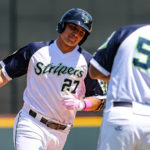
AA: .333/.394/.677 | 109 PA | 6 HR | 0 SB | 7.3 BB% | 25.7 K% | 189 wRC+
AAA: .312/.365/.455 | 85 PA | 3 HR | 1 SB | 8.2 BB% | 30.6 K% | 131 wRC+
No prospect in the Braves system has done more to solidify himself in the Braves long-term plans than Austin Riley, who has been an an offensive tear since being promoted up to AA mid-season 2017. Concerns about his “long swing” have largely been alleviated thanks to improved pitch recognition allowing him to start his swing earlier and staying in front of the pitch.
Riley has also improved his defense to be above average. His reactions off the bat are very good, and he’s always had a cannon arm. Riley is facing his third week of AAA pitching, and once he gets his strikeout numbers to standard slugger territory of ~25%, he may get a shot in Atlanta.
See also: Braves Sunday Farm Report, 5/20/2018
7. Ian Anderson, RHP
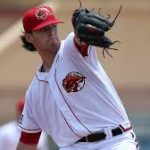
A+: 3.64 ERA | 2.77 FIP | 9 G, 9 GS | 42.0 IP | 4.07 BB/9 | 11.14 K/9
Success has been a very simple formula for Anderson. When he can control his fastball and allow his plus secondary offerings to play, he can be as dominating as any pitcher in the Braves system. When he can’t, he’s probably in for a short outing. Right now it’s a coin flip to see which of these scenarios play out on any given outing. That said, the upside on Anderson remains extremely high and his ceiling remains a true top-of-the-rotation starting pitcher.
8. Max Fried, LHP
AA: 0.00 ERA | 2.78 FIP | 1 G, 1 GS | 4.2 IP | 5.79 BB/9 | 11.57 K/9
AAA: 3.80 ERA | 2.92 FIP | 4 G, 4 GS | 21.1 IP | 3.80 BB/9 | 8.44 K/9
MLB: 4.09 ERA | 6.47 FIP | 5 G, 1 GS | 11.0 IP | 5.73 BB/9 | 10.64 K/9
Fried has been a bit of a yo-yo early on this year. Squeezed by numbers to AA to start the season, Fried had one start with Mississippi before being recalled to Gwinnett to replace the injured Aaron Blair in the rotation. Fried would make two starts with Gwinnett before getting called up to pitch out of the bullpen for Atlanta. Fried’s stretch in the bullpen from April 24 through May 4 was rocky as he allowed 4 runs and 3 home runs in 6 innings.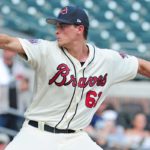
Fried was returned to Gwinnett where he started twice more before getting called up to pitch a spot start that got rained out. Fried finally got a start for Atlanta on May 28, pitching 5 solid innings against Jacob deGrom and the Mets, a game the Braves ended up winning in the 9th.
It’s difficult to get a good read on Fried, as his four-game stint in the bullpen was so disastrous it colors his good work as a starter at three different levels. Add in that he had a six-day gap in appearances between his 4/18 start with Gwinnett and his first relief appearance in Cincinnati, and one has to wonder how he could have stayed sharp. One thing that’s for certain is that his continued success will rely heavily on how well he can command his pitches, especially the curveball.
9. Cristian Pache, OF
A+: .281/.304/.395 | 195 PA | 2 HR | 4 SB | 3.6 BB% | 17.9 K% | 98 wRC+
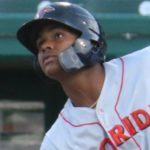 Pache is in the midst of overhauling his offensive game. The process is ongoing, but the proof is in the sharp increase in line drives and decrease in ground balls. His emphases on making contact has resulted in both a decreased walk and strikeout rate as well. If he can fold back in the selectiveness he demonstrated as an 18-year-old with Rome last year, he could be a force at the top of a line-up. Pache is only two extra base hits away from matching his total last season with Rome, and he got his first two official professional home runs on the books.
Pache is in the midst of overhauling his offensive game. The process is ongoing, but the proof is in the sharp increase in line drives and decrease in ground balls. His emphases on making contact has resulted in both a decreased walk and strikeout rate as well. If he can fold back in the selectiveness he demonstrated as an 18-year-old with Rome last year, he could be a force at the top of a line-up. Pache is only two extra base hits away from matching his total last season with Rome, and he got his first two official professional home runs on the books.
His speed, defense, and arm strength tools are still among the best in the minor leagues and his floor is higher than any position player prospect on this list other than the gentleman at the top.
10. Touki Toussaint, RHP
AA: 3.58 ERA | 3.21 FIP | 10 G, 10 GS | 50.1 IP | 3.93 BB/9 | 11.80 K/9

Toussaint has seemingly entered the “finishing school” phase of his minor league career, and he’s been utilizing all the weapons at his disposal. His curveball remains a devastating swing-and-miss pitch, and Toussaint has been throwing it more than ever before. When he’s got fastball command to go with the curve, he’s the most dominating starting pitcher in the Braves minor leagues.
That command isn’t present in all of his outings however, which is essentially the one chink in his armor at this point. When Toussaint misses, he tends to miss in the zone with either the four-seam fastball or the sinker that he started to throw in 2017. Hitters, knowing that they probably can’t do anything with the curve, tend to sit on the fastball. Toussaint needs to figure out how to be competitive when things aren’t working perfectly, but he’s not far away.
11. Bryse Wilson, RHP
A+: 0.34 ERA | 2.38 FIP | 5 G, 5 GS | 26.2 IP | 2.36 BB/9 | 8.78 K/9
AA: 3.74 ERA | 3.98 FIP | 4 G, 4 GS | 21.1 IP | 3.32 BB/9 | 9.14 K/9
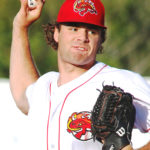
The Braves drafted four high-ceiling prep pitchers in the opening rounds of the 2016 draft. Wilson was the fourth of the four, and has blown through exceptions by being the first to get to the AA level, and Wilson needed to move up because he desperately needed a challenge.
Wilson’s 2017 season in Rome was defined by being efficient at generating outs. That trend has continued, and Wilson can maintain command and velocity deep into games. This year he has improved on his change-up to complement his fastball/slider combo that generates a ton of groundballs. Since his promotion he’s found hitters that are more selective and less likely to attack those pitches, so it will be interesting to see how he will adjust.
12. Joey Wentz, LHP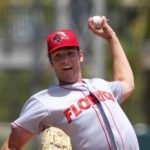
A+: 3.77 ERA | 4.82 FIP | 7 G, 7 GS | 28. 2 IP | 5.97 BB/9 | 7.22 K/9
Wentz dominated the A level in 2017, but has run into some mechanical trouble early in 2018. While Wentz was his customary dominant self in his first three Fire Frog starts, Wentz has had difficulty with his control over his last four starts. Jason Woodell of Prospects1500 has seen two of Wentz’s starts this month and immediately noted issues with his release point and use of his legs.
Wentz has not made a start since 5/11 despite not having gone on the DL. Presumably Wentz and his coaches are breaking down his mechanics in order to get him back on track.
13. Alex Jackson, C
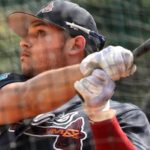
AA: .187/.279/.276 | 140 PA | 1 HR | 0 SB | 8.6 BB% | 30.0 K% | 98 wRC+
After an impressive half-season in AA in 2017 followed up with a strong performance in the Arizona Fall League, many were penciling Jackson for an Atlanta debut in September.
The lesson learned is that catching prospects almost always move just a touch slower than everyone else. Jackson hasn’t gotten on track at the plate, and is at the point now where he seems to be pressing, going after pitches off the plate. Without an incentive to throw strikes, Jackson hasn’t hit with his customary power. I haven’t noticed anything unfixable in his swing, so here’s hoping Jackson breaks out of this slump in June.
Behind the plate Jackson has made advances in blocking and game-calling. Coming out of spring training, his reactions seemed slow and his focus sometimes wavered, but at least defensively he looks back on track.
14. A.J. Minter, LHP

MLB: 3.74 ERA | 3.62 FIP | 24 G, 0 GS | 21.2 IP | 5.40 BB/9 | 9.14 K/9
Minter has surpassed the major league service time minimum to no longer be considered a prospect, so this will be the last time he will appear on an OFR prospect list.
While Minter has looked dominant at times, he also has had some fairly typical rookie adjustments to make. Most interestingly, the control Minter exhibited in the minor leagues has not translated immediately to the major leagues. This can be attributed to major league hitters being more selective, but it seems to this observer that Minter has morphed his slider into more of a cut fastball. While the cutter is finding the zone more often than the fastball, it’s getting hit more as well, to the tune of .302/.362/.396. This has gotten more pronounced as the season has gone on.
This leads me to notice that he is already within 17 innings of his professional season high. I have to wonder if a tactical DL stint may be in order soon.
15. Patrick Weigel, RHP
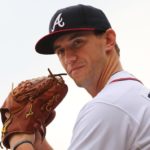
AAA: DNP
Weigel is now about 11 and a half months out from his UCL replacement surgery. The Braves are one of the more conservative clubs about the time frame for getting back onto the mound, so I wouldn’t expect Weigel to return for rehab action until late July. If all goes well, he could pitch in the Arizona Fall League to get innings in before spring training 2019.

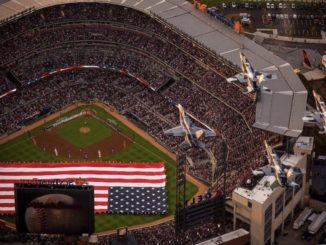

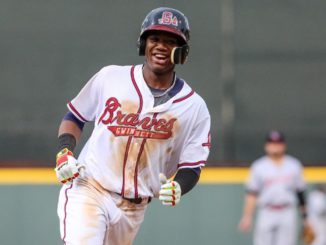
Leave a Reply